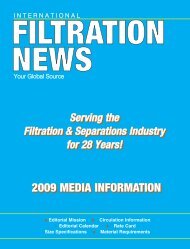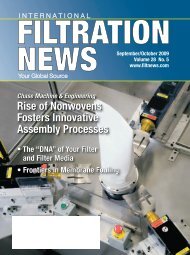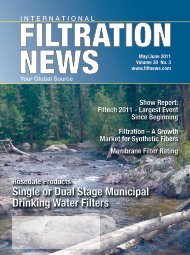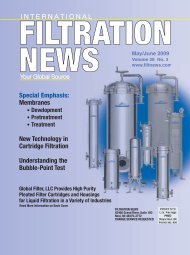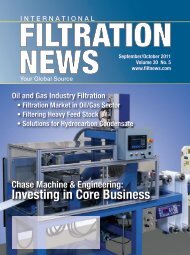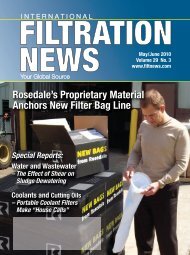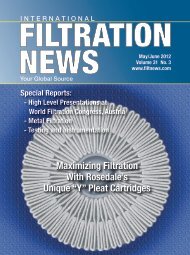2011 Buyers' Guide 2011 Buyers' Guide - International Fiber Journal
2011 Buyers' Guide 2011 Buyers' Guide - International Fiber Journal
2011 Buyers' Guide 2011 Buyers' Guide - International Fiber Journal
- No tags were found...
Create successful ePaper yourself
Turn your PDF publications into a flip-book with our unique Google optimized e-Paper software.
get organic compound removal performancedifferences. Four of the sampleswere carbon blocks and the fifthwas a granular activated carbon (GAC)containing ion exchange material. Thesorbent materials were removed fromeach POU device. Blocks were analyzedas broken chunks. Removed materialwas dried in an oven at 110˚C for threehours to remove water. A low dryingtemperature was used to avoid sorbentdamage and typically drying is done at150˚C. It is important to compare differentsorbents performance on a dryweight basis.During GAED sample preparationall five samples lost less than 2% moistureby weight. This indicates that allfive samples were clean and dry. Thisconditioning step allows the GAED tocalculate all activities and adsorptioncapacities on a clean carbon basis.GAED SAMPLE RUNSAfter each sample was cleaned andweighed, it was challenged with flowingadsorbent gas 1,1,1, 2-tetraflouroethane(TFE). When physical adsorption occursTFE gas is liquefied to a liquid likestate by graphitic London adsorptionforces. The TFE adsorbed weight increasesas the sample temperature is decreased,and decreases as the sampletemperature is increased. The mass adsorbedwas plotted against temperature,but the relative pressure was also changing.There are three variables affectingadsorption performance that changefrom point to point: vapor pressure,partial pressure, and temperature.The GAED samples and standardruns measured between 273 and 340quasi-equilibrium adsorption and desorptiondata points covering seven ordersof magnitude in relative pressure(isothermal basis) and three orders ofmagnitude in carbon loading. The massadsorbed on each of the nine specimenswas also divided by the carbon mass toprovide a weight percent loading foreasier comparisons.GAED CHARACTERISTIC CURVESThe tabular data and characteristiccurves are shown in Table 1 and Figure1. The 273 to 340 adsorption/desorptiondata points per run were interpolatedto get 30 evenly spaced pointscovering the entire temperature range.Next the adsorption and desorption resultswere averaged to get the quasiequilibriumvalues in Table 1. Thedifference between adsorption and desorptionwas minimal for all nine runs,thus demonstrating no carbon hysteresisas expected.The y-axis in Figure 1 are pore volumemeasured in cubic centimeter (cc)TFE liquid adsorbed /100 grams carbon,instead of a weight percent. Theadsorbed TFE weighs were divided byits bulk density, to convert a w/w basisto a v/w basis, for easier comparisons.PERFORMANCE PREDICTIONSFigure 1 characteristic curves arethe only carbon related informationrequired to predict physical adsorptionperformance using the Polanyi AdsorptionPotential theory 3 . To do performancepredictions the followingwww.filtnews.com • August 2010 • 21





